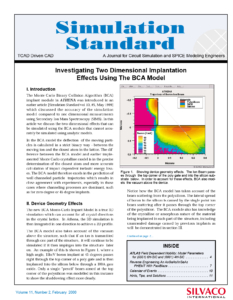Investigating Two Dimensional Implantation Effects Using The BCA Model
I. Introduction
The Monte Carlo Binary Collision Algorithm (BCA) implant module in ATHENA was introduced in an earlier article [Simulation Standard Vol 10, #5, May 1999] which discussed the accuracy of the simulation model compared to one dimensional measurements using Secondary Ion Mass Spectroscopy (SIMS). In this article we discuss the two dimensional effects that can be simulated using the BCA module that cannot accurately be simulated using analytic models.
In the BCA model the deflection of the moving particles is calculated in a strict binary way&between the moving ion and the closest atom in the lattice. The difference between the BCA model and earlier implemented Monte Carlo crystalline model is in the precise determination of the closest atom and more accurate calculation of impact dependent inelastic energy losses. The BCA model therefore excels in the prediction of well-channeled particle trajectories which results in close agreement with experiments, especially in those cases where channeling processes are dominant, such as for zero degree or 45 degree implants.



